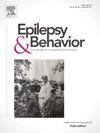Cenobamate and pregnancy: A-single level 4 epilepsy center experience
IF 2.3
3区 医学
Q2 BEHAVIORAL SCIENCES
引用次数: 0
Abstract
Objective
Data on Cenobamate (CNB) use in females of childbearing age with epilepsy (FCAWE) and during pregnancy is limited. We report four patients who became pregnant on CNB and its pharmacokinetic profile during pregnancy.
Methods
Single-center retrospective chart review of FCAWE receiving CNB between 2020 and 2024. Data on contraceptive use, pregnancy outcomes, and medication levels were analyzed.
Results
147 out of 215 adult female patients received CNB were FCAWE. Thirty-three patients had documented use of contraceptive methods. Four unintended pregnancies occurred. Contraceptive methods included condoms (n = 1), hormonal contraceptive (n = 2), and no contraception (n = 1). One had a live early-term birth, two had elective terminations due to medical comorbidities, and one had spontaneous miscarriage. The child born had no reported congenital malformations or developmental delays up to 5 months of age. One patient had ASM levels measured throughout pregnancy and post-partum period, displaying a trend towards decreased concentration-to-dose ratio (CDR) during pregnancy compared to baseline and similar levels in the one-month post-partum period.
Discussion
While our report remains anecdotal and preliminary given the very small sample size, we underscore the importance of pre-conceptual counseling in FCAWE to prevent unintended pregnancies and undesired outcomes, particularly when using ASM with limited data regarding teratogenicity. We also shed light on drug level monitoring during pregnancy.
新生儿和妊娠:单一4级癫痫中心经验
目的关于Cenobamate (CNB)在育龄女性癫痫(FCAWE)和妊娠期使用的数据有限。我们报告了4例服用CNB怀孕的患者及其在怀孕期间的药代动力学特征。方法对2020 - 2024年接受CNB治疗的FCAWE患者进行单中心回顾性分析。分析了避孕药具使用、妊娠结局和药物水平的数据。结果215例接受CNB的成年女性患者中有147例为FCAWE。33名患者有使用避孕方法的记录。发生了四次意外怀孕。避孕方法包括避孕套(n = 1)、激素避孕(n = 2)和不避孕(n = 1)。其中一人活产早产,两人因医疗合并症而选择终止妊娠,一人自然流产。出生的孩子没有先天性畸形或发育迟缓的报道,直到5个月大。一名患者在整个妊娠期和产后期间测量了ASM水平,与基线和产后一个月的类似水平相比,妊娠期间显示出浓度剂量比(CDR)下降的趋势。虽然我们的报告仍然是轶事和初步的,因为样本量很小,我们强调孕前咨询在FCAWE中预防意外怀孕和不良后果的重要性,特别是在使用ASM时,关于致畸性的数据有限。我们还阐明了怀孕期间的药物水平监测。
本文章由计算机程序翻译,如有差异,请以英文原文为准。
求助全文
约1分钟内获得全文
求助全文
来源期刊

Epilepsy & Behavior
医学-行为科学
CiteScore
5.40
自引率
15.40%
发文量
385
审稿时长
43 days
期刊介绍:
Epilepsy & Behavior is the fastest-growing international journal uniquely devoted to the rapid dissemination of the most current information available on the behavioral aspects of seizures and epilepsy.
Epilepsy & Behavior presents original peer-reviewed articles based on laboratory and clinical research. Topics are drawn from a variety of fields, including clinical neurology, neurosurgery, neuropsychiatry, neuropsychology, neurophysiology, neuropharmacology, and neuroimaging.
From September 2012 Epilepsy & Behavior stopped accepting Case Reports for publication in the journal. From this date authors who submit to Epilepsy & Behavior will be offered a transfer or asked to resubmit their Case Reports to its new sister journal, Epilepsy & Behavior Case Reports.
 求助内容:
求助内容: 应助结果提醒方式:
应助结果提醒方式:


